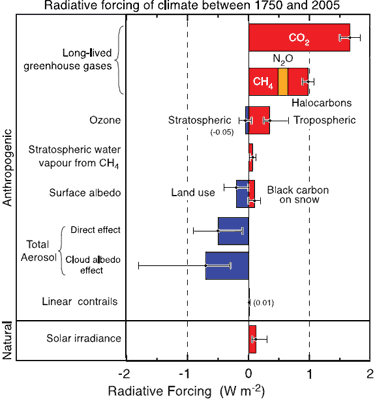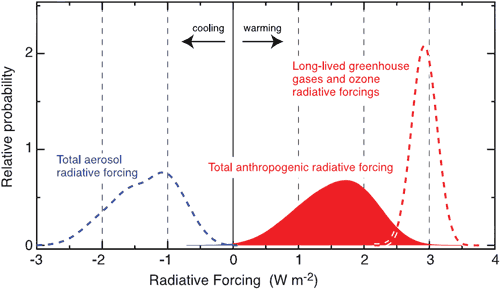CO2 is not the only driver of climate
Posted on 25 October 2009 by John Cook
Climate scientists tend to go on a bit about CO2. However, as readers often point out, CO2 is not the only driver of climate. There are a myriad of other radiative forcings that affect the planet's energy imbalance. Volcanoes, solar variations, clouds, methane, aerosols - these all change the way energy enters and/or leaves our climate. So why the focus on CO2? Is it because scientists are all hysterical treehuggers determined to run peoples' lives with a one world government? Or is there a rational, scientific reason for this CO2 preoccupation? Let's find out which...
When I first started investigating global warming science, I attempted to discern the cause by a process of elimination. I studied all possible causes and ruled out any that couldn't be causing all the warming. As my understanding grew, I came to realise this was an inappropriate approach. Understanding what drives climate does not occur by a process of elimination. It's happens by a process of integration. There are many influences of climate and they all need to be considered together to gain the full picture.
For clarity, let me note a few definitions. Radiative forcing is loosely defined as the change in net energy flow at the top of the atmosphere. In this post, we're talking about the radiative forcing from 1750 to 2005. Values are taken from Chapter 2 of the IPCC AR4 which in turn took all their values from peer reviewed papers - apologies that I was too lazy to cite all the original sources. Positive radiative forcing has a warming effect (so obviously, negative radiative forcing has a cooling effect).
- Surface Albedo has changed due to activity such as deforestation. This increases the Earth's albedo - the planet's surface is more reflective. Consequently, more sunlight is reflected directly back into space, giving a cooling effect of -0.2 Wm-2.
- Ozone affects the climate in two ways. The depletion of stratospheric ozone is estimated to have had a cooling effect of -0.05 Wm-2. Increasing tropospheric ozone has had a warming effect of +0.35 Wm-2.
- Solar variations affect climate in various ways. The change in incoming Total Solar Irradiance (TSI) has a direct radiative forcing. There is an indirect effect from UV light which modifies the stratosphere. The radiative forcing from solar variations since pre-industrial times is estimated at +0.12 Wm-2. Note that the radiative forcing from solar variations may be amplified by a possible link between galactic cosmic rays and clouds. However, considering the sun has shown a slight cooling trend over the last 30 years, an amplified forcing from solar variations would mean a greater cooling effect on global temperatures during the modern warming trend over the last 35 years.
- Volcanoes send sulfate aerosols into the stratosphere. These reflect sunlight, cooling the earth. A strong volcanic eruption can have a radiative forcing effect of up to -3 Wm-2. However, the effect of volcanic activity is transitory - over several years, the aerosols wash out of the atmosphere and any long term forcing is removed.
- Aerosols have two effects on climate. They have a direct cooling effect by reflecting sunlight - this is calculated from observations to be -0.5 Wm-2. They also have an indirect effect by affecting the formation of clouds which in turn affect the Earth's albedo. The trend in cloud cover is one of increasing albedo which means a cooling effect of -0.7 Wm-2.
- Stratospheric Water Vapour has increased due to oxidation of methane and had a slight warming effect of +0.07 Wm-2.
- Linear Contrails from aviation have a slight warming effect of +0.01 Wm-2.
- Nitrous Oxide reached a concentration of 319ppb in 2005. As a greenhouse gas, this contributes warming of +0.16 Wm-2.
- Halocarbons (eg - CFC's) were used extensively in refrigeration and other industrial processes before they were found to cause stratospheric ozone depletion. As a greenhouse gas, they cause warming of +0.337 Wm-2.
- Methane is actually a more potent greenhouse gas than CO2. Pre-industrial methane levels, determined from ice core measurements, were around 715 parts per billion (ppb). Currently methane rates are at 1774 ppb (eg - 1.774 parts per million). The radiative forcing from methane is +0.48 Wm-2.
- CO2 levels have increased from around 280 parts per million (ppm) in pre-industrial times to 384 ppm in 2009. The radiative forcing from CO2 is +1.66 Wm-2. CO2 forcing is also increasing at a rate greater than any decade since 1750.
Here's a visual summary of the various radiative forcings:

Figure 1: Global mean radiative. Anthropogenic RFs and the natural direct solar RF are shown. (IPCC AR4 Figure 2.20a)
Putting it all together, Figure 2 compares the warming from human caused greenhouse gases to the total radiative forcing from all human sources.

Figure 2: Probability distribution functions (PDFs) from combining anthropogenic radiative forcings. Three cases are shown: the total of all anthropogenic radiative forcings (block filled red curve); Long-lived greenhouse gases and ozone radiative forcings (dashed red curve); and aerosol direct and cloud albedo radiative forcings (dashed blue curve). Surface albedo, contrails and stratospheric water vapour RFs are included in the total curve but not in the others. Natural radiative forcings (solar and volcanic) are not included in these three PDFs. (IPCC AR4 Figure 2.20b)
Greenhouse gases and ozone contribute warming of +2.9 Wm-2. The majority of this is from CO2 (+1.66 Wm-2). This warming is offset by anthropogenic aerosols, reducing the total human caused warming to 1.6 Wm-2. So surprisingly, the warming from CO2 actually exceeds the final total radiative forcing. If ever asked how much CO2 contributes to global warming, you could say "all of it... and some!" But a more appropriate response would be to list the various contributors of forcing, both negative and positive, although this may cause the questioner's eyes to glaze over (and wish they'd never asked). Framing science is never easy.
The other important point to glean from Figure 2 is that we have a relatively high understanding of greenhouse gas radiative forcing. The probability density function (PDF) shows a much higher probability than the aerosols PDF, meaning the uncertainty associated with greenhouse gas forcing is much lower. This degree of confidence is also confirmed by experimental observations from both satellites and surface measurements which confirm the degree of enhanced greenhouse effect from rising greenhouse gases.
So bringing it all together, there are two reasons for the focus on CO2:
- CO2 is the most dominant radiative forcing
- CO2 radiative forcing is increasing faster than any other forcing
UPDATE: just read an interview with climate scientist Ken Caldeira which focuses on the issue of geoengineering. But one particular quote summed up the issues discussed above:
Question: They also write that you are convinced that human activity is responsible for “some” global warming. What does that mean?
Caldeira: I don’t think we can say with certainty whether we’re responsible for 90 percent of it or we might be responsible for 110 percent of it. But the vast majority of global warming, I believe, is due to human release of greenhouse gases to the atmosphere.































 Arguments
Arguments























 0
0  0
0






Comments